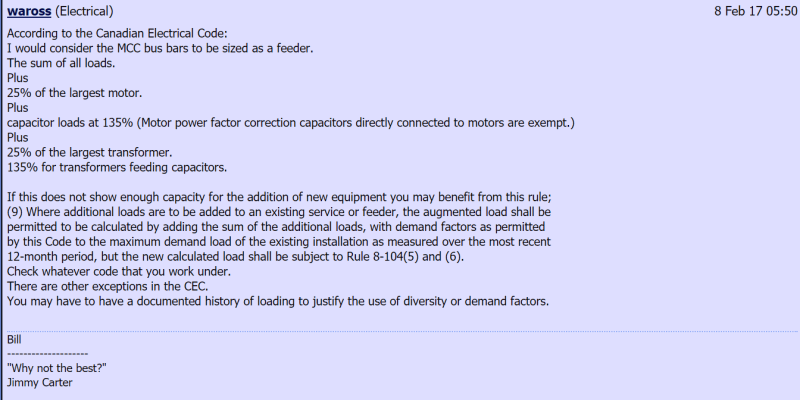Hello,
I am trying to add an additional load to a MCC switchboard that has a bus bar rating of 800A. I want to verify if adding the load will lead to exceeding the capacity of the bus bar rating or not. I am in Canada and the code that I follow is Canadian Electrical Code part 1.
Sum of the full load amps of all connected loads after adding the new load is coming out to be 736A. Does this mean I am okay, or do I need to multiply 736A by 125% to check the bus bar capacity. I am confused because when a cable is selected, Canadian Electrical Code part 1 specifies to multiply 125% to the full load amps, but not sure if that is applicable even for a busbar.
Below is the link to a different discussion thread on this similar topic -
thread238-420754
In one of the posts in the above discussion thread, I noticed that @waross mentioned about adding 25% of the largest motor, 135% of the capacitor loads, 25% of the largest transformer and 135% of the transformer feeding capacitors to the sum of the full load amps of all connected loads. Below is the snip of the reply from @waross that I am referring -

Can someone provide me the reference clause number to the rule that @waross has mentioned his reply?
I am trying to add an additional load to a MCC switchboard that has a bus bar rating of 800A. I want to verify if adding the load will lead to exceeding the capacity of the bus bar rating or not. I am in Canada and the code that I follow is Canadian Electrical Code part 1.
Sum of the full load amps of all connected loads after adding the new load is coming out to be 736A. Does this mean I am okay, or do I need to multiply 736A by 125% to check the bus bar capacity. I am confused because when a cable is selected, Canadian Electrical Code part 1 specifies to multiply 125% to the full load amps, but not sure if that is applicable even for a busbar.
Below is the link to a different discussion thread on this similar topic -
thread238-420754
In one of the posts in the above discussion thread, I noticed that @waross mentioned about adding 25% of the largest motor, 135% of the capacitor loads, 25% of the largest transformer and 135% of the transformer feeding capacitors to the sum of the full load amps of all connected loads. Below is the snip of the reply from @waross that I am referring -

Can someone provide me the reference clause number to the rule that @waross has mentioned his reply?
